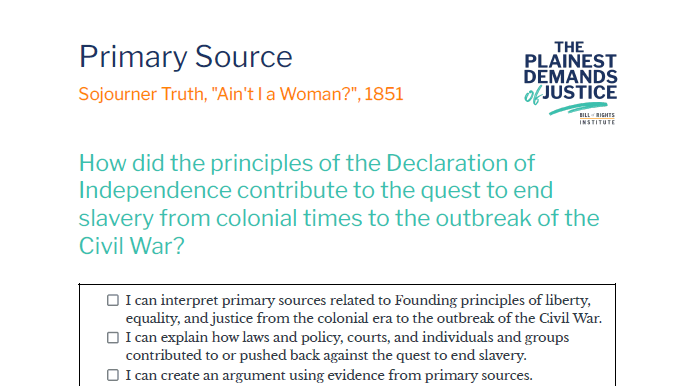Sojourner Truth, “Ain’t I a Woman?” 1851
How did the principles of the Declaration of Independence contribute to the quest to end slavery from colonial times to the outbreak of the Civil War?
- I can interpret primary sources related to Founding principles of liberty, equality, and justice from the colonial era to the outbreak of the Civil War.
- I can explain how laws and policy, courts, and individuals and groups contributed to or pushed back against the quest to end slavery.
- I can create an argument using evidence from primary sources.
- I can analyze issues in history to help find solutions to present-day challenges.
Building Context
Sojourner Truth was an abolitionist and advocate for women’s rights. Truth was born enslaved and escaped from slavery with one of her infant children. She was deeply religious and through her religion met other reformers such as William Lloyd Garrison and Frederick Douglass. These connections enabled her to speak at a convention for women’s rights in 1851. What Truth actually said in this speech is unknown. She was illiterate, and the only transcriptions of her speech come from differing secondhand accounts. What we do know is that her haunting message of her life as a slave brought her national attention. She spent the rest of her life working for the African American community, supporting black soldiers during the Civil War, and helping formerly enslaved families escape from the Confederacy. After the Civil War, she helped formerly enslaved families start a new life out West.
She was illiterate, and the only transcriptions of her speech come from differing secondhand accounts. To read two different transcriptions of this speech and analyze further, see this activity from our Life, Liberty, and the Pursuit of Happiness curriculum.
Sojourner Truth, “Ain’t I a Woman?”, 1851
Source: https://billofrightsinstitute.org/activities/sojourner-truth-aint-i-a-woman-1851
And ain’t I a woman? Look at me! Look at my arm! [and she bared her right arm to the shoulder, showing her tremendous muscular power]. I have ploughed, and planted, and gathered into barns, and no man could head me! And ain’t I a woman? I could work as much and eat as much as a man—when I could get it—and bear de lash as well! And ain’t I a woman? I have borne thirteen chilern, and seen ‘em mos’ all sold off to slavery, and when I cried out with my mother’s grief, none but Jesus heard me! And ain’t I a woman? . . .
Comprehension and Analysis Questions
- Truth gave her speech at a women’s rights convention. How does she combine women’s rights with the cause of abolition in her speech?
- Why would Truth’s speech resonate emotionally with listeners?
